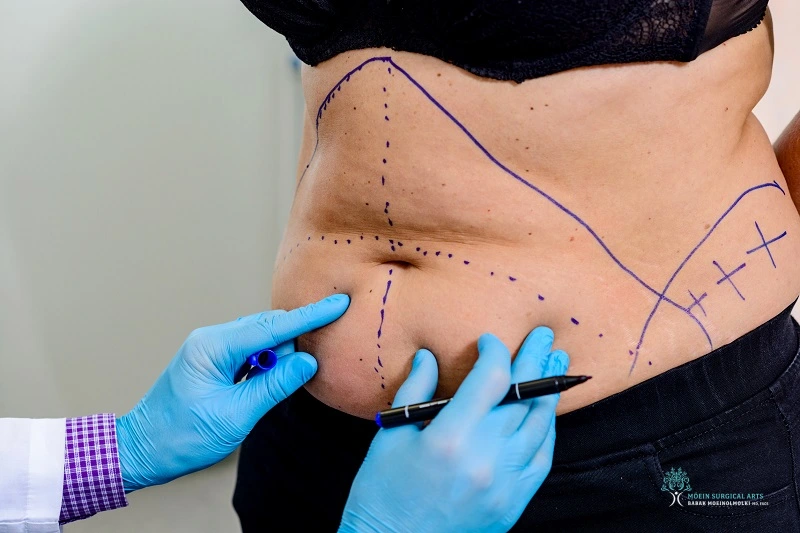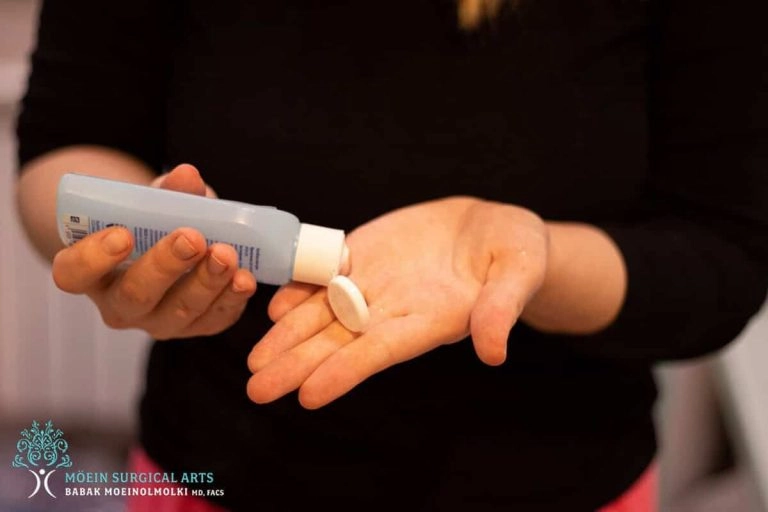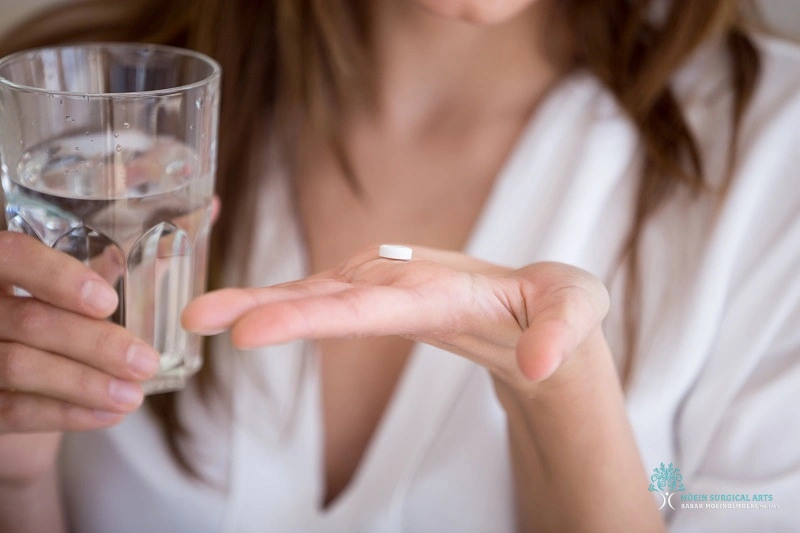
The six-week mark after undergoing a tummy tuck procedure is a crucial milestone in the recovery process. By this time, patients can expect significant progress in their healing journey. This section will delve into the various aspects of the recovery timeline, potential side effects, and the importance of follow-up appointments at this point.

Reaching the six-week mark signifies a substantial step towards regaining full functionality and normalcy. By this time, patients often experience a reduction in pain and discomfort, and their incisions begin to heal significantly. It is during this period that individuals may gradually resume their usual activities, including exercising and lifting more substantial weights, under the guidance of their surgeon.
While the initial weeks post-operative are crucial for healing, the six-week mark is when patients can expect to see more pronounced improvement in their body contour and overall well-being. Specific side effects, such as swelling and bruising, will continue to diminish during this period.
It is essential to mention that individual patients may experience a variation in their healing timeline and potential side effects. However, these are topics that will be explored further in subsequent sections. Additionally, scheduling follow-up appointments with the surgeon is crucial at this point to ensure that progress is monitored and any concerns are addressed promptly.
In conclusion, the six-week post-operative period after a tummy tuck marks a significant recovery milestone. In the following sections, we will discuss in detail the specific progress, potential side effects, and the importance of following up with your surgeon during this stage of the healing process.
The recovery process following a tummy tuck, also known as an abdominoplasty, is crucial for achieving optimal results and ensuring a smooth healing journey. In this post, we will provide a week-by-week guide to help you understand the phases of tummy tuck recovery and what to expect during each stage. From immediately after surgery to several weeks post-op, we will take you through the timeline of recovery, highlighting essential milestones and offering helpful tips for a successful and comfortable healing experience. Let’s delve into the week-by-week tummy tuck recovery timeline.

Day 1 of tummy tuck surgery marks an important step towards achieving a more contoured abdomen. Upon completion of the procedure, patients will require assistance to return home, as the effects of general anesthesia will leave them feeling groggy and unable to drive. It is crucial to arrange for a responsible adult to accompany and provide transportation.
In the initial hours following the surgery, patients will experience grogginess due to the anesthesia. This grogginess generally lasts for several hours, during which time the patient is advised to rest and refrain from any strenuous activities. The patient may also feel some discomfort, which is typical after this type of surgery. This discomfort can range from mild to moderate and may be managed with prescribed pain medication.
Given the significance of Day 1 in the recovery process, rest is highly recommended to aid the healing process. While it is important to move around periodically to promote blood circulation, it is crucial to avoid any strenuous activities for the first day. It is also essential to follow the surgeon’s instructions concerning post-operative care, such as dietary restrictions and proper wound care.
In summary, on Day 1 of tummy tuck surgery, a designated driver is necessary due to the grogginess experienced after general anesthesia. Patients can anticipate discomfort which can be alleviated by prescribed medication. Rest is crucial during this period to promote healing, with minimal physical activities advised.
During the first week of tummy tuck recovery, it is crucial to strictly adhere to the recommended restrictions in order to ensure proper healing and minimize any potential complications. The following activities should be avoided during this period:
It is important to consult with the surgeon for specific guidelines and restrictions tailored to the individual’s condition and needs. Compliance with these instructions will help ensure a smooth and successful recovery from a tummy tuck surgery.
During week 2 of tummy tuck recovery, it is crucial to avoid certain activities that may hinder the healing process and affect the optimal results of the procedure. Firstly, vigorous exercise should be completely avoided. This includes activities such as running, weightlifting, and high-intensity workouts. Engaging in these activities too soon can put strain on the healing incisions, leading to complications and delays in the recovery process.
Additionally, it is important to refrain from smoking and drinking alcohol during week 2 and beyond. Smoking delays the healing process by constricting blood vessels and restricting oxygen flow, while alcohol can interfere with medications and increase the risk of complications. Both substances can also impair the body’s ability to heal and increase the risk of infection.
In terms of diet, it is advised to continue limiting sodium intake and drinking plenty of water. Reducing sodium intake can help prevent excessive swelling, while staying well-hydrated promotes overall healing and aids in flushing out toxins from the body.
To optimize healing and achieve desirable results, patients should lightly massage the treated area as advised by their surgeon. Massaging can help improve blood circulation and promote tissue healing. Additionally, using scar minimizing techniques, such as silicone sheets or silicone gel, can help reduce the appearance of scars over time. Lastly, wearing compression garments, as instructed by the surgeon, promotes proper healing by providing support to the treated area and reducing swelling.
By following these guidelines and avoiding certain activities, maintaining a healthy diet, practicing scar minimizing techniques, and utilizing compression garments, patients can experience optimal healing and achieve the best possible results after a tummy tuck procedure.
During week 3 of tummy tuck recovery, it is important to continue following post-operative instructions to ensure proper healing and minimize complications. While restrictions from physical activity are gradually lifted, it is crucial to proceed with caution and avoid strenuous exercises.
Specific activities during week 3 can include gentle walking and light stretching to gradually increase mobility. However, heavy lifting, vigorous workouts, and activities that strain the abdominal muscles should still be avoided. It is advisable to consult with the surgeon before starting any new exercise routine.
Precautions should also be taken during week 3 to protect the incision site and promote healing. It is essential to observe proper scar care by keeping the incision clean and dry, avoiding direct sunlight, and applying any prescribed ointments or dressings. Wearing loose-fitting clothing or compression garments can help reduce swelling and support the healing process.
Following a well-balanced diet that includes ample protein, vitamins, and minerals is important for optimal healing. Staying hydrated and getting sufficient rest are also key factors in promoting a speedy recovery.
In summary, week 3 of tummy tuck recovery involves gradually increasing physical activity, maintaining proper scar care, and following a healthy lifestyle. It is crucial to adhere to the post-operative instructions and consult with the surgeon for personalized advice.

During week 4 of tummy tuck recovery, it is important to continue addressing key points such as gradually increasing physical activity, scar care, maintaining a healthy diet, and additional restrictions or precautions.
Gradually increasing physical activity is crucial during this stage of recovery. While it is important to stay active to promote healing and prevent blood clots, sudden, intense exercises should be avoided. Patients can begin with light walking or stretching exercises and slowly progress to more strenuous activities. It is important to listen to the body’s signals and not push too hard, as overexertion can delay healing.
Continuing scar care is essential in week 4 of tummy tuck recovery. Regularly cleaning the incision area with mild soap and water and gently patting it dry is recommended. Applying silicone gel or sheets can help minimize scarring. Massaging the scar with lotion or oil can also aid in reducing its appearance. It is vital to avoid exposing the scar to direct sunlight and wearing tight clothing that may irritate the incision site.
Maintaining a healthy diet is important for proper healing during week 4 of tummy tuck recovery. Consuming a balanced diet that is rich in vitamins, minerals, and protein will support the body’s healing process. Staying hydrated is also crucial as it assists in wound healing and prevents complications.
Additional restrictions and precautions include avoiding heavy lifting, bending, or straining the abdominal muscles. Patients should also refrain from smoking and consuming alcohol, as these can impede the healing process. It is important to attend all follow-up appointments with the surgeon during week 4 to monitor progress and address any concerns promptly.
In conclusion, week 4 of tummy tuck recovery requires a gradual increase in physical activity, continued scar care, maintaining a healthy diet, and adhering to additional restrictions and precautions. By following these guidelines, patients can promote proper healing and achieve optimal results from their tummy tuck surgery.
During week 5 after tummy tuck surgery, it is important to continue following specific activities, dietary guidelines, and care instructions to ensure a successful recovery.
Activities:
Dietary guidelines:
Care instructions:
Strenuous exercise can be resumed only with your surgeon’s approval to prevent any complications. Additionally, maintaining a healthy diet, consistently following scar treatments, and wearing compression garments will contribute to optimal healing and results.
Get expert guidance from Dr. Moein on your personalized recovery timeline and what to expect at every stage of healing.
📞 Call Now: (310) 455-8020 💬 Request Free Consultation✓ Board-Certified Surgeon • ✓ Personalized Care • ✓ Los Angeles Premier Facility
During week 6 after surgery, it is crucial for patients to continue following their post-operative care routine in order to aid in their recovery process. This week marks an important milestone as patients can begin to gradually resume certain activities, with prior approval from their surgeon.
One key aspect of the post-operative care routine that should be continued during week 6 is applying scar treatments. Applying these treatments, such as creams or ointments, can help minimize the appearance of scars and promote faster healing. Patients should carefully follow the instructions provided by their healthcare provider when applying these treatments.
Additionally, wearing compression garments should still be a priority during week 6. These garments help reduce swelling, promote blood circulation, and provide support to the treated areas. Consistently wearing compression garments aids in the overall recovery process.
Maintaining a healthy diet is also crucial during week 6 after surgery. Consuming a balanced diet rich in nutrients supports the body’s healing process. Patients should focus on including fruits, vegetables, lean proteins, and whole grains in their meals to provide the necessary vitamins and minerals for optimal recovery.
With the approval of their surgeon, patients can gradually start resuming certain activities during week 6. These activities may include light household chores, walking short distances, or engaging in low-impact exercises. It is important to follow the surgeon’s guidelines and take things slowly to avoid any complications or setbacks.
In summary, week 6 after surgery requires patients to continue with scar treatments, wearing compression garments, and maintaining a healthy diet. The resumption of certain activities can be gradually initiated with the approval of the surgeon. By following these instructions, patients can ensure a successful and smooth recovery process.
Tummy tuck recovery tips are essential for anyone considering or undergoing this popular cosmetic surgery procedure. A tummy tuck, also known as an abdominoplasty, is a surgical procedure that removes excess fat and skin from the abdominal area, resulting in a flatter and more toned midsection. While the surgery itself is significant, the recovery process is equally important in ensuring optimal results and a smooth healing experience. By following specific recovery tips, individuals can minimize discomfort, reduce the risk of complications, and shorten their overall recovery time. In this article, we will explore some valuable tummy tuck recovery tips that will aid patients in achieving a successful and comfortable recuperation after their surgery.

Compression garments play a crucial role in tummy tuck recovery by providing support and aiding in the healing process. These specially designed garments apply gentle pressure to the treated area, offering a multitude of benefits.
One of the most significant advantages of compression garments is their ability to prevent fluid buildup. After a tummy tuck procedure, the body naturally produces excess fluid as part of the healing process. Compression garments help to reduce the amount of fluid buildup by promoting proper drainage. This helps to minimize the risk of complications, such as seroma formation, which occurs when fluid accumulates under the skin.
In addition to preventing fluid buildup, compression garments also help in reducing post-surgical swelling. The gentle compression provided by these garments helps to support the tissues, minimizing excessive swelling and promoting faster healing. Swelling can cause discomfort and limit mobility, so reducing it is crucial for a smoother recovery.
Compression garments also play a vital role in protecting the incision sites. They provide a barrier between the incisions and external elements, reducing the risk of infection and improving wound healing. By keeping the incision sites secure and protected, compression garments contribute to a better overall healing process.
Another advantage of compression garments is their ability to contour the abdomen. These garments provide support and compression that helps mold the tissues, promoting a smoother and more even result. They can help to minimize the appearance of irregularities and create a more aesthetically pleasing contour.
Lastly, compression garments can minimize the risk of wound breakdown. The pressure applied by these garments helps to stabilize the tissues, reducing tension on the incisions. This can help to prevent wound separation or opening, resulting in more successful healing.
In conclusion, compression garments are an essential component of tummy tuck recovery. They aid in preventing fluid buildup, reducing post-surgical swelling, protecting incision sites, contouring the abdomen, and minimizing the risk of wound breakdown. By wearing compression garments as recommended by the surgeon, patients can experience a smoother and faster recovery process.
A front-wheeled walker is a mobility aid commonly used in the recovery process following surgery. Its purpose is to provide stability and support to individuals who have limited balance or strength, allowing them to regain their mobility with ease. By using a front-wheeled walker, patients can experience several key benefits.
Firstly, a front-wheeled walker aids in walking with a safe posture. This is crucial during the recovery period as it reduces the risk of falls and further injury. The design of the walker enables the user to maintain a slightly bent-over posture, which promotes stability and prevents strain on the back muscles. This ensures that the body is properly aligned during the walking process, minimizing the likelihood of accidents and allowing for a more controlled and secure movement.
Moreover, the front-wheeled walker reduces pressure on the back muscles. When recovering from surgery, individuals may experience pain and discomfort in their back muscles due to the surgical procedure and limited movement. By using a front-wheeled walker, the pressure on the back muscles is alleviated, as the walker bears the weight of the upper body. This enables individuals to navigate their surroundings and engage in walking exercises without straining their back muscles, thus promoting a faster and less painful recovery.
In conclusion, utilizing a front-wheeled walker in the recovery process after surgery has various advantages. It assists in maintaining a safe, slightly bent-over posture, which reduces the risk of falls and promotes stability. Additionally, it minimizes pressure on the back muscles, allowing for a more comfortable rehabilitation experience. Overall, a front-wheeled walker is an essential aid that facilitates mobility and enhances the recovery journey after surgery.
Wound Care Supplies:
When it comes to wound care, having the necessary supplies on hand is essential for proper healing and to prevent infection. Here is a list of the necessary wound care supplies, including gauze pads, to address various types of wounds, including incisions:
Remember, it is important to consult a healthcare professional or follow medical guidelines for proper wound care. This list provides a basic overview of the necessary wound care supplies, but the specific requirements may vary depending on the severity and type of wound.

Over-the-counter (OTC) pain medication plays a significant role in managing post-operative pain. After undergoing surgery, patients commonly experience discomfort and pain during the recovery process. OTC pain medication can be an effective and accessible option for relieving post-operative pain and improving the patient’s overall well-being.
There are several types of OTC pain medication commonly used for managing post-operative pain. Nonsteroidal anti-inflammatory drugs (NSAIDs) such as ibuprofen and aspirin are frequently used due to their dual action of reducing pain and inflammation. Acetaminophen, another commonly used OTC pain reliever, focuses primarily on reducing pain and does not have the anti-inflammatory properties of NSAIDs.
The benefits of OTC pain medication for post-operative pain management are numerous. These medications are easily accessible, allowing patients to obtain relief without a prescription. They are also typically less expensive compared to prescription pain medications, making them more affordable for patients. OTC pain medications also offer various dosage forms, such as tablets, capsules, and liquid formulations, providing flexibility for individual preferences.
Despite the benefits, it is important to be aware of potential side effects that may arise from using OTC pain medication. NSAIDs, for example, can irritate the stomach lining and may increase the risk of gastrointestinal bleeding. Acetaminophen, if taken in excessive amounts, may cause liver damage. It is essential to follow the recommended dosage and seek medical advice if any adverse effects are experienced.
In conclusion, OTC pain medication is highly relevant in managing post-operative pain. Their accessibility, affordability, and effectiveness make them a practical choice for patients. However, it is crucial to understand the types of OTC pain medications available, their benefits, and potential side effects to ensure safe and appropriate usage.
Scar Gel is a highly effective scar treatment that aims to diminish the appearance of scars after incision sites have fully healed. This revolutionary gel provides an array of benefits and has gained immense popularity in the field of scar management.
The primary benefit of Scar Gel lies in its ability to significantly reduce the visibility of scars. By applying the gel to the affected area, it works to improve the skin’s texture and color, gradually fading the scar. It also helps to smoothen and soften the skin, making the scar less noticeable and more aesthetically pleasing.
To achieve optimal results, Scar Gel should be applied to fully healed incision sites. It is recommended to use the gel twice daily, gently massaging it in circular motions until fully absorbed. Consistent usage is key to achieving desired outcomes, and it is important to be patient, as the speed of results may vary depending on the severity of the scar.
The key features of Scar Gel include its non-greasy formula, which allows for easy application and quick absorption into the skin. It is also fragrance-free and does not contain any potentially irritating ingredients, making it suitable for sensitive skin types.
The powerful ingredients of Scar Gel include a unique blend of botanical extracts, such as aloe vera and onion extract, which have been scientifically proven to improve scar appearance. Additionally, it contains silicone, which forms a protective layer over the scar, preventing excessive moisture loss and enabling optimal healing conditions.
In conclusion, Scar Gel offers a multitude of benefits for scar treatment, effectively diminishing the appearance of scars after incision sites have fully healed. With its easy application process and key ingredients, this gel provides a reliable solution for scar management, ensuring improved skin texture and color.

Using a recliner for sleep during recovery offers numerous benefits, especially when the patient needs to sleep at a 45-degree angle for an extended period. One of the key advantages is that a recliner provides the optimal angle for reducing strain on the body and promoting effective healing. By elevating the upper body and legs, pressure is relieved from the back and joints, allowing the body to relax and heal more efficiently.
Compared to sleeping in a bed, patients often find a recliner much more comfortable during the recovery phase. The adjustable positions of a recliner enable individuals to find the perfect angle that suits their specific needs. This customization allows for personalized comfort, reduces discomfort caused by medical devices or injuries, and promotes better sleep quality. Additionally, recliners often have built-in lumbar support and cushioning, which further enhance comfort and alleviate any pain or discomfort.
In cases where a reclining chair is not readily available, it is highly recommended to rent one for the recovery period. Renting a recliner offers a cost-effective solution, as it allows patients to have access to the necessary equipment without the need for a significant investment. Moreover, rental recliners are often maintained in excellent condition, ensuring optimal functionality and comfort for the patient’s recovery needs.
In conclusion, using a recliner for sleep during recovery provides essential benefits such as the ability to maintain a 45-degree angle and alleviate strain on the body. Its superior comfort compared to beds makes it an ideal choice for patients. Renting a reclining chair is a practical option to ensure the patient’s comfort and aid in their recovery process.
Tummy tuck procedures are quite common, but the recovery process can be challenging. To ensure a smooth and comfortable recovery, several tips can be followed.
Maintaining a healthy diet is crucial during tummy tuck recovery. Eating a balanced diet rich in fruits, vegetables, lean proteins, and whole grains helps the body heal faster and provides essential nutrients. It promotes tissue repair, reduces inflammation, and boosts the immune system. Additionally, drinking an adequate amount of water is essential to stay hydrated, flush out toxins, and prevent constipation.
Taking probiotics is another beneficial step for tummy tuck recovery. Probiotics help restore the balance of gut bacteria, which can be disrupted due to surgical procedures and antibiotic use. This promotes healthy digestion, reduces bloating, and enhances nutrient absorption.
Consuming ginger tea is recommended as it can alleviate nausea and aid digestion. Ginger has anti-inflammatory properties that can help reduce swelling and discomfort after a tummy tuck.
Using arnica gel or cream can also contribute to a comfortable recovery. Arnica is a natural remedy that can reduce bruising, swelling, and pain. Gently massaging the gel or cream onto the affected areas can speed up the healing process.
In conclusion, following these tummy tuck recovery tips, including maintaining a healthy diet, drinking water, taking probiotics, consuming ginger tea, and using arnica gel or cream, can greatly aid in a comfortable and successful recovery. It is important to consult with a healthcare professional for personalized advice based on individual circumstances.
In conclusion, the recovery process at 6 weeks post-op for a tummy tuck procedure is crucial for achieving optimal results. At this stage, patients can expect significant progress in their recovery and overall well-being.
One of the key points in the recovery process is maintaining a healthy lifestyle. This includes following a balanced diet and exercise routine. A healthy diet helps support the body’s healing process and aids in reducing swelling and inflammation. Similarly, regular exercise promotes blood circulation and muscle tone, which can enhance the outcome of the tummy tuck by improving the overall aesthetic appearance of the abdomen.
Wearing a compression garment is another essential aspect of recovery. This garment helps to minimize swelling, promote drainage of excess fluid, and provide support to the treated area. By wearing the compression garment as directed, patients can experience faster recovery and an improved contour of their abdomen.
Furthermore, scheduling lymphatic drainage massages can greatly contribute to the recovery process. These specialized massages help to reduce swelling, improve circulation, and enhance the elimination of toxins from the body. By promoting lymphatic drainage, patients can achieve a smoother and more refined appearance of their abdomen.
In conclusion, the recovery process at 6 weeks post-op for a tummy tuck is dependent on maintaining a healthy lifestyle, wearing a compression garment, and scheduling lymphatic drainage massages. By adhering to these factors, patients can expect to see significant progress in their recovery and experience the desired results of their tummy tuck procedure.
Schedule your tummy tuck consultation with Dr. Moein today and discover how expertly planned recovery leads to exceptional results.
📞 Call: (310) 455-8020 📅 Book ConsultationCan’t Visit In Person? No Problem!
📱 Schedule Virtual Consultation